 |
 |
|||||||||||||||||||||
|
||||||||||||||||||||||
AZFO FIELD EXPEDITION
Lake Mead Aquatic Bird Survey
November 7-9, 2014
By Eric Hough
High numbers of water birds move through the state in late fall, with constant potential for finding rare loons, grebes, ducks, and gulls that only occur inland in small numbers during migration, or that get off track from their usual migration pathways. Lake Mead, the large reservoir between Arizona and Nevada that holds water from the Colorado, Virgin, and Muddy Rivers behind Hoover Dam, is one such water body that is likely an important stopover point for migrating water birds. However, this area of Mohave County in northwestern Arizona is largely under-birded, so the relative usage by water birds on the Arizona side of this reservoir is not well known. Water levels have been significantly reduced by drought and water usage by large cities in Arizona, Nevada, and California in recent years, with this summer having the lowest level since Hoover Dam was constructed in 1931. At almost 150 feet below capacity, it was also of interest to us to see how water birds might be affected by the lowering of this reservoir and how they might be utilizing different areas. On this expedition, AZFO was joined by southern Nevada’s Red Rock Audubon Society to survey for aquatic bird species at several access points on the Arizona side of Lake Mead. In addition to counting water birds, we looked for local resident Le Conte’s Thrashers along with other residents and migrants in the Mojave desert-scrub and Joshua tree forest surrounding the reservoir in between driving to different vantage points on Lake Mead. Some of the participants also visited nearby Willow Beach along the Colorado River below Hoover Dam. In the Appendix, see Table 1 for results of the water bird counts at Lake Mead and Table 2 for incidental land bird counts.
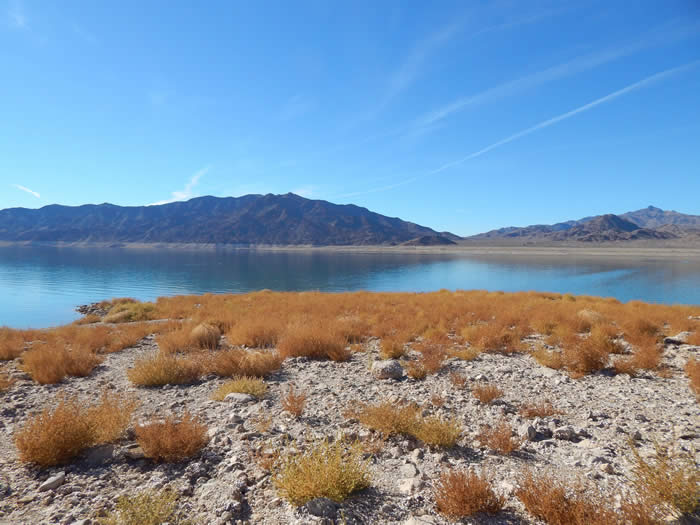 |
| Figure 1. South Cove at Lake Mead (© Eric Hough). |
FRIDAY, NOVEMBER 7, 2014
Seven of the participants from as far away as Sierra Vista, Tempe, Mesa, Heber, Flagstaff, and Lake Havasu City, Arizona, met up in the afternoon at Temple Bar Campground near the marina at Lake Mead to secure campsites and bird around the campground. On the way to the campground, a few of us attempted to look for and conduct playbacks for Le Conte’s Thrashers in the sparsely-vegetated, creosote flats along the Temple Bar Rd., but were unsuccessful in detecting this local species. We were pleasantly surprised to find that the campground was very vegetated compared to the stark desert surrounding it, with a fairly high density of exotic eucalyptus and palm trees, and oleander bushes throughout the campground. Some of the dripping sprinkler systems were also drawing in resident and migrant passerines, with our highlights including a Greater Roadrunner, Gambel’s Quail, a Northern Flicker, a Bewick’s Wren, two Ruby-crowned Kinglets, two American Robins, five Cedar Waxwings, dozens of Yellow-rumped Warblers and White-crowned Sparrows, and a Spotted Towhee.
Just before dusk we checked nearby Temple Bar Marina, tucked into a narrow cove with a partially-obscured view of the lake. We only found eight species of water birds here (see Temple Bar visit #1 in Table 1 of the Appendix), with highlights including a Mexican Duck X Mallard intergrade, a couple of Double-crested Cormorants, and a flock of 22 gulls that were too distant to identify to species. We also got to watch a pair of Red-tailed Hawks, one individual a dark/rufous morph, on the rocky hillside, along with four American Pipits foraging close to us in the mud on the shoreline.
SATURDAY, NOVEMBER 8, 2014
Temple Bar Campground & Marina
In addition to the same species as the day before in the campground, we also had a Cooper’s Hawk and a Pine Siskin come through while we got breakfast out of the way. Once Theresa Hyde’s group of four from southern Nevada arrived, our collective group of 11 birded together at the Temple Bar Marina before later splitting up. At the marina, similar low diversity and numbers of waterfowl as the previous afternoon was encountered (see Temple Bar visit #2 in Table 1 of the Appendix) while we briefly conversed and took in the scenery of the distant Temple Bar butte across the lake. American Pipits and Rock Wrens also provided some entertainment.
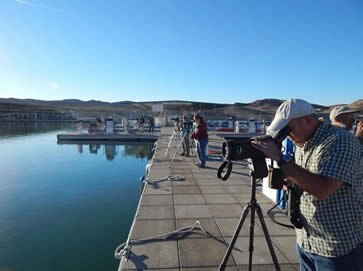 |
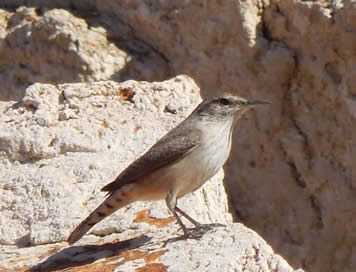 |
|
| Figure 2. a) AZFO and Red Rock Audubon Society participants scoping Lake Mead from Temple Bar Marina (© Eric Hough) and | b) Rock Wren (© Eric Hough). |
After a quick group photo, we then split into three groups to canvass the Arizona shoreline of Lake Mead, with Theresa Hyde, Mike Baker, David Bradford, and Je Anne Blackman going up to Bonelli Landing and Bonelli Bay before heading back to Nevada; David Vander Pluym, Lauren Harter, and Tom Hildebrandt covering South Cove, Pearce Ferry, the Joshua tree forest near the turn for Grand Canyon West, and a visit to Bonelli Landing late in the day; and myself, Anne Pellegrini, James McKay, and John Barthelme covering Gregg’s Hideout, a visit to South Cove a few hours after the other group had visited that site, and the Joshua tree forest south of Meadview. Some of the groups did visits to the same locations hours apart of each other in order to capture any turn-over in birds throughout the day, which we did detect.
[NOTE: While Temple Bar Rd. (accessed from Hwy. 93 north of Dolan Springs) and Pierce Ferry Rd. (accessed at Dolan Springs) up to South Cove are paved roads in excellent condition, the roads to Bonelli Landing and Bonelli Bay (accessed off Temple Bar Rd.), Gregg’s Hideout (accessed from Pierce Ferry Rd. northeast of Dolan Springs), and Pearce Ferry (forking off the paved road going to South Cove) currently have rocky and sandy sections. High-clearance, 4WD vehicles are needed to visit Bonelli Landing, Bonelli Bay, Gregg’s Hideout, and Pearce Ferry.]
 |
| Figure 3. Map of coverage area that AZFO and Red Rock Audubon visited around the Arizona side of Lake Mead on November 7-9, 2014 (© Google Earth 2014). |
Bonelli Landing & Bay
On the way to Bonelli Landing and Bay, the Red Rock Audubon Society contingent stopped at a couple of points in the desert to try for land birds, including at Detrital Wash where they had a few Yellow-rumped Warblers and White-crowned Sparrows, and an American Goldfinch among common Mohave Desert resident species. At Bonelli Landing and Bay they encountered good diversity and numbers of water birds, indicating some feature(s) of this part of the lake being more attractive to both dabbling and diving species. The first vantage point they scanned from was Bonelli Bay, a cove similar in its narrow dimensions to Temple Bar Marina. Here they detected 16 species of water birds, with highlights including a Common Loon and a Bonaparte’s Gull (see Bonelli Bay visit #1 in Table 1 of the Appendix). In the surrounding desert, highlights of the land birds present included a Greater Roadrunner and two Crissal Thrashers. Just to the west at Bonelli Landing, they encountered 16 species of aquatic birds, including a Red-breasted Merganser, five Common Loons, two Horned Grebes, 11 American White Pelicans, 32 Ring-billed Gulls, and three Herring Gulls (see Bonelli Landing visit #1 in Table 1 of the Appendix). A couple of Western Meadowlarks were also seen in the weed patches along the shoreline.
In the late afternoon, Lauren, David, and Tom also visited Bonelli Landing. Showing the turnover potential that a given location on a reservoir can have throughout the day, they had 24 species of water birds, including 15 Snow Geese, a Ross’s Goose, four Red-breasted Mergansers, seven Common Loons, five Horned Grebes, a Great Egret, 100 Ring-billed Gulls and an additional 50 unidentified gulls (see Bonelli Landing visit #2 in Table 1 of the Appendix).
 |
Figure 4. View from Bonelli Landing on Lake Mead (© Eric Hough). |
Gregg’s Hideout
On our way to Gregg’s Hideout, we saw several incidental birds along the powerlines and in the desert around Dolan Springs, including one Ferruginous and several Red-tailed Hawks, American Kestrels, and Loggerhead Shrikes. On the road to Gregg’s Hideout, we stopped once in a semi-flat area of creosote to try playbacks for Le Conte’s Thrashers, although we were unsuccessful in yielding any. Upon pulling into the cove of Gregg’s Hideout, we immediately saw a few Sagebrush Sparrows fly up from the weeds. We were amazed at how low the water level was given the previous high water line visible on the mountain slopes and we saw lots of rocks covered with bleached, dried out mussel shells. To get a better view of the lake, we climbed up the slope and hiked out to on the peninsular point to scope for birds. We were surprised by how few aquatic bird species were utilizing this section of Lake Mead, which is narrower here than at other sections of the reservoir. Here we only had five species of water birds (see Table 1 of the Appendix), including a distant loon on the Nevada side of the lake that we were not able to get good enough looks at to identify. A few nearby Rock Wrens kept us company with their inquisitive behavior as we scanned the lake.
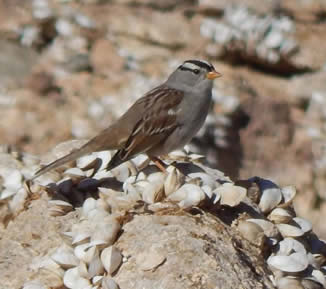 |
 |
|
Figure 5. a) ‘Gambel’s’ White-crowned Sparrow atop bleached mussels (© Eric Hough) and
|
b) Gregg’s Hideout at Lake Mead (© Eric Hough). |
South Cove & Pearce Ferry
Earlier in the day, Tom, Lauren, and David visited South Cove, a recreation site and boat launch at a wide spot on the east side of Lake Mead north of Meadview. This location held modest numbers of 10 species of water birds (see South Cove visit #1 in Table 1 of the Appendix), with highlights including four Common Goldeneyes, a couple of Clark’s Grebes, and six Bonaparte’s Gulls. Out towards the stateline on the lake they spotted 50+ scaups, a Common Loon, and a couple hundred Aechmophorus (Western/Clark’s) grebes. Birding around the weedy patches surrounding the boat launch and picnic sites, they also encountered large mixed foraging flocks of Yellow-rumped Warblers (including one ‘Myrtle’), White-crowned Sparrows, and House Finches. In addition, they also found a couple of House and Bewick’s Wrens, and American Goldfinches.
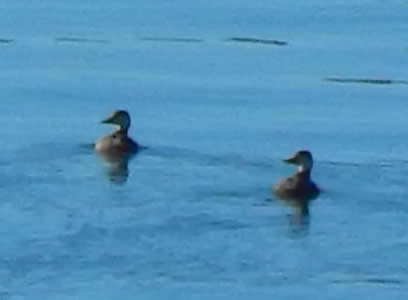 |
Figure 6. Black Scoters at South Cove (© Eric Hough). |
A couple of hours later, James, Anne, John, and I visited South Cove after we had checked out the scant numbers of water birds at Gregg’s Hideout. We had similar numbers and diversity of water birds (see South Cove visit #2 in Table 1 of the Appendix), but did pick up one rare species that the other group had not seen earlier: a pair of female Black Scoters! This is the rarest of the scoter species occurring in migration in Arizona, but has been more frequently observed in recent years (about 25 records now), especially along the lower Colorado River. We were able to get closer to them by hiking across a ridge to look down upon them and obtain some sufficient photo documentation. After observing and photographing the birds for a while, a powerboat going by spooked the birds, which we proceeded to watch fly all the way across the lake well into Nevada waters. Thus, we were able to submit a report to the Nevada Rare Birds Committee for these individuals, as well. We also found five Common Goldeneyes, 25+ Clark’s Grebes, and a Ring-billed Gull, although we did not see some of the other duck species or the Bonaparte’s Gulls that the earlier group had detected. Additionally, we found the same mixed passerine flocks working the weed patches and tamarisk clumps, including at least four American Goldfinches. We also flushed a Western Meadowlark from weeds on the shoreline and heard a Crissal Thrasher giving its whistled “churry-churry” calls nearby.
Joshua tree forest south of Meadview
Driving northeast towards Meadview from Dolan Springs, one begins to see some modest Joshua tree forest, but it is not until you get past the lower hills that you see a truly spectacular sight: a sea of tall Joshua trees spreading out across a valley towards the dramatic Grand Wash Cliffs and the western end of the Grand Canyon. Just east of the intersection of the turn for Grand Canyon West from Pierce Ferry Rd. there are some dirt pullouts that two of our groups stopped at to look for resident land birds. A local denizen of mostly Sonoran Desert to the south that inhabits Joshua tree forest at the northern edge of its range, a Gilded Flicker was found by Lauren, David, and Tom. They also witnessed a flock of about 60 Pinyon Jays wandering the area, no doubt originating from the pinyon-juniper woodlands on the north-facing slopes of the nearby mountains. Their group also detected a couple of Ladder-backed Woodpeckers, Cactus and Bewick’s Wrens, and wintering Dark-eyed Juncos. Later in the day, my group found a flock of about 45 Pinyon Jays. Just getting to check out the majestic Joshua trees themselves was well worth the stop!
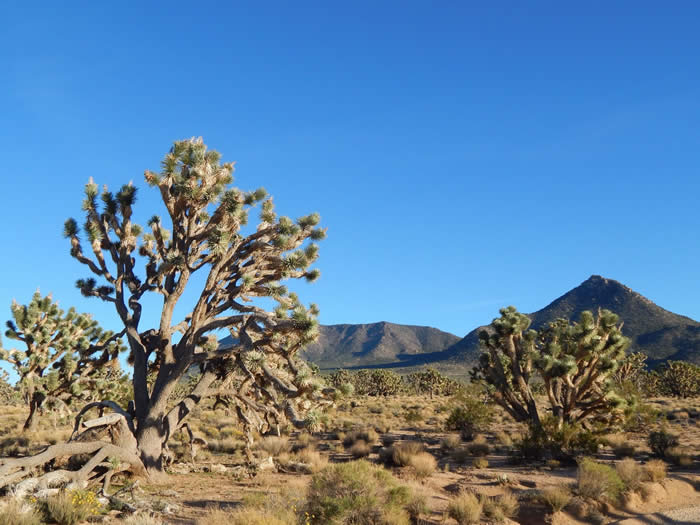 |
Figure 7. Joshua tree forest near Meadview (© Eric Hough). |
Temple Bar Campground (redux)
Back at the campground that evening, the Arizona contingent heard a Great Horned Owl, saw several shooting stars, and even got to take in the amazing site of what we later determined was a large passenger jet being refueled in the air while escorted by several fighter jets. This squashed our theory that it was Airforce One being escorted overhead, as apparently neither President Obama nor Vice-President Biden were traveling in that part of the country that day. It was still a memorable sight to see the silhouettes of jets escorting the plane in the dusk light, low over Lake Mead!
SUNDAY, NOVEMBER 9, 2014
Temple Bar Campground
The next morning at the campground we heard the same robins, waxwings, warblers, and sparrows moving through the trees as the previous few days, with the addition of at least one ‘Myrtle’ Yellow-rumped Warbler. As we ate breakfast, broke camp, and discussed the day’s game plan, we also saw the silhouette of the Cooper’s Hawk perched in a snag against the backdrop of the setting moon. A couple of American Pipits called as they passed over the campground, too.
Bonelli Landing & Bay
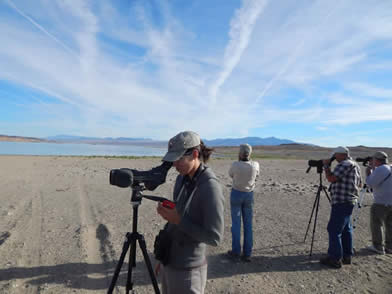 |
Along the road out to Bonelli Landing and Bay from the Temple Bar Rd., we stopped at a few spots in the creosote flats and wide washes to conduct audio playbacks of Le Conte’s Thrashers. This was one of the areas that Lauren and David had detected the species a few years prior on an AZFO expedition, but on this day we failed to get any responses to the callbacks. Outside of breeding season these birds do get quieter and harder to spot, but perhaps they also move around more outside of their home ranges and territories during autumn. At the northern end of their range in the state where they are already locally-distributed, they likely have very large home ranges to travel within on the wide expanse of creosote flats. But, as with any survey, negative data is still data!
Our first stop on the lake that morning was at Bonelli Landing, which provides a wide view of the reservoir. With the darker colored mountains across the lake, the “bathtub rings” marking the previous high water marks of the reservoir were especially evident. While we had some of the same species that the Red Rock Audubon group had the day before, we also saw evidence of turnover here (see Bonelli Landing visit #3 in Table 1 of the Appendix). Highlights of the 28 species of water birds that our group of seven had included 96 Redheads, a Greater Scaup, a few Red-breasted and Common Mergansers, six Common Loons, nine Horned and five Clark’s Grebes, a Great Egret, an Osprey (which we got to see catch and devour a large fish!), and large gull flocks consisting of Bonaparte’s, Ring-billed, California, and Herring Gulls. A Northern Harrier, a couple dozen American Pipits, and Savannah Sparrow added some spice to the land birds we incidentally detected while scoping the lake.
Just to the east at the narrower view from Bonelli Bay, we had 19 species of water birds (see Bonelli Bay visit #2 in Table 1 of the Appendix), with notable finds including a Common Loon, six Clark’s Grebes, a few late migrant Least Sandpipers, and smaller numbers of Bonaparte’s, Ring-billed, and California Gulls than we had at the previous stop. Our only Northern Rough-winged Swallow of the trip did a quick pass over us here.
Willow Beach
After our group had split up by late morning for everyone to make the long drives back to their homes across the state, David, Lauren, Anne, and I made a quick trip just northwest of the Temple Bar Rd. turn-off from Hwy. 93 to Willow Beach along the Colorado River downstream of Hoover Dam. This location has a marina and an adjacent fish hatchery with some small trees around. Water birds that we found on the Arizona side of the river that are not included in Table 1 of the Appendix for Lake Mead included five American Wigeons, six Mallards, one Ring-necked Duck, 15 Buffleheads, one Ruddy Duck, two Pied-billed Grebes, four Eared Grebes, 19 Double-crested Cormorants, ~200 American Coots, and four Killdeer. The Nevada side of the river had five Gadwalls, five American Wigeons, six Mallards, one Greater Scaup, 25 Bufflheads, one Ruddy Duck, three Eared Grebes, and ~200 American Coots. Along the Arizona shoreline, land birds included Black and Say’s Phoebes, two Ruby-crowned Kinglets, a Cedar Waxwing, and a ‘Myrtle’ Yellow-rumped Warbler.
Overall, this expedition succeeded in obtaining a snapshot of late fall migration of water birds on this under-birded reservoir. Some of the locations we checked had more numbers and species richness than others, possibly due to water depth variability or abundance of food (fish, algae, mussels). Due to the lack of regular flooding and nutrient deposition into the lake because of damming upstream and shoreline vegetation that is seen at other reservoirs on the river, many parts of the lake may essentially be “dead zones” that do not attract the number of water birds that other areas do. This is seen when comparing to areas on the Nevada side of Lake Mead, such as Las Vegas Bay, which attract much more diversity and numbers of water birds by the existence of high nutrient inflow via Las Vegas Wash. Only time and continued observation will tell how the perpetually decreasing water level of Lake Mead through drought and overuse by metropolitan areas will affect the aquatic birds that use this reservoir as a migration stopover or a wintering site.
We would like to thank the 11 participants that traveled long distances to help gather this information on water bird use of Lake Mead! We hope that you will join us on our upcoming expeditions in 2015!
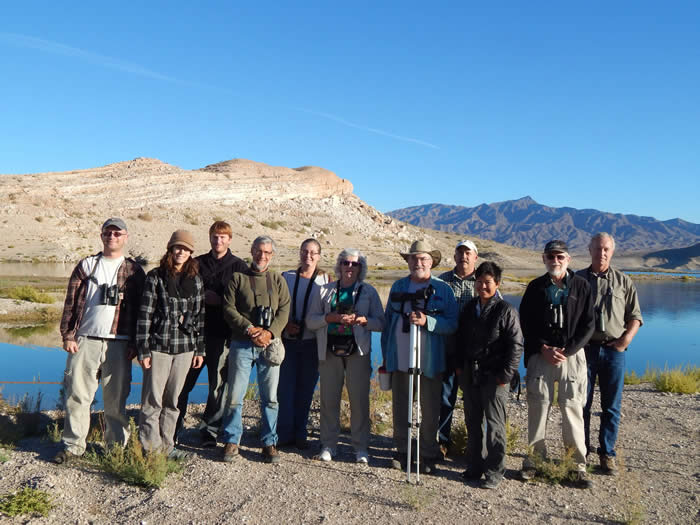 |
Figure 9. AZFO and Red Rock Audubon Society expedition participants at Temple Bar Marina (left to right): Eric Hough, Lauren Harter, David Vander Pluym, John Barthelme, Anne Pellegrini, Je Anne Blackman, Tom Hildebrandt, James McKay, Theresa Hyde, David Bradford, and Mike Baker. |
Appendix A
Table 1. Results of water bird counts at vantage points on Arizona side of Lake Mead plus birds seen on the Nevada side of the reservoir across from these points. Willow Beach numbers not included here.
| Species | Site | Bonelli Bay |
Bonelli Landing |
South Cove |
Gregg's Hideout |
Temple Bar |
NV |
TOTAL | |||||
|---|---|---|---|---|---|---|---|---|---|---|---|---|---|
| Visit # | 1 |
2 |
1 |
2 |
3 |
1 |
2 |
1 |
1 |
2 |
|||
| Snow Goose | 15 |
15 |
|||||||||||
| Ross's Goose | 1 |
1 |
|||||||||||
| Gadwall | 6 |
3 |
4 |
8 |
1 |
22 |
|||||||
| American Wigeon | 15 |
1 |
12 |
35 |
4 |
67 |
|||||||
| Mallard | 8 |
2 |
5 |
4 |
19 |
||||||||
| Northern Shoveler | 4 |
5 |
1 |
10 |
|||||||||
| Northern Pintail | 18 |
25 |
6 |
39 |
88 |
||||||||
| [dabbling duck sp.] | 7 |
7 |
|||||||||||
| Canvasback | 6 |
1 |
2 |
9 |
|||||||||
| Redhead | 4 |
40 |
110 |
95 |
96 |
19 |
2 |
3 |
369 |
||||
| Ring-necked Duck | 6 |
16 |
20 |
42 |
|||||||||
| Greater Scaup | 1 |
1 |
|||||||||||
| Lesser Scaup | 1 |
8 |
17 |
30 |
56 |
||||||||
| [Lesser/Greater Scaup | 8 |
58 |
66 |
||||||||||
| [Aythya sp.] | 20 |
20 |
|||||||||||
| Black Scoter | 2 |
2 |
*2 |
||||||||||
| Bufflehead | 6 |
2 |
1 |
1 |
10 |
||||||||
| Common Goldeneye | 4 |
5 |
9 |
||||||||||
| Common Merganser | 1 |
65 |
4 |
70 |
|||||||||
| Red-breasted Merganser | 1 |
4 |
4 |
9 |
|||||||||
| Ruddy Duck | 27 |
30 |
40 |
90 |
60 |
10 |
19 |
4 |
28 |
308 |
|||
| [duck sp.] | 3 |
120 |
230 |
353 |
|||||||||
| Common Loon | 1 |
1 |
5 |
7 |
6 |
1 |
21 |
||||||
| [loon sp.] | 1 |
1 |
|||||||||||
| Pied-billed Grebe | 2 |
8 |
10 |
10 |
2 |
1 |
4 |
2 |
39 |
||||
| Horned Grebe | 2 |
5 |
9 |
16 |
|||||||||
| Eared Grebe | 2 |
6 |
1 |
1 |
10 |
20 |
|||||||
| Western Grebe | 131 |
35 |
58 |
30 |
40 |
5 |
5 |
35 |
25 |
364 |
|||
| Clark's Grebe | 6 |
5 |
2 |
25 |
38 |
||||||||
| [Western/Clark's grebe] | 50 |
50 |
60 |
30 |
10 |
548 |
748 |
||||||
| Double-crested Cormorant | 2 |
1 |
1 |
2 |
12 |
2 |
3 |
3 |
28 |
||||
| American White Pelican | 11 |
11 |
|||||||||||
| Great Blue Heron | 1 |
1 |
1 |
2 |
5 |
||||||||
| Great Egret | 1 |
1 |
1 |
3 |
|||||||||
| Osprey | 1 |
1 |
|||||||||||
| American Coot | 320 |
375 |
1600 |
1500 |
1700 |
80 |
200 |
85 |
125 |
125 |
450 |
6560 |
|
| Killdeer | 1 |
1 |
|||||||||||
| Least Sandpiper | 4 |
4 |
|||||||||||
| Bonaparte's Gull | 1 |
1 |
1 |
6 |
9 |
||||||||
| Ring-billed Gull | 31 |
4 |
32 |
100 |
190 |
1 |
358 |
||||||
| California Gull | 8 |
19 |
27 |
||||||||||
| Herring Gull | 3 |
2 |
5 |
||||||||||
| [gull sp.] | 50 |
22 |
10 |
82 |
|||||||||
Table 2. Results of incidental, non-aquatic bird counts around Lake Mead and Willow Beach.
Species |
Total |
Species |
Total |
| Gambel's Quail | 21 |
Balck-tailed Gnatcatcher | 5 |
| Northern Harrier | 1 |
Ruby-crowned Kinglet | 5 |
| Cooper's Hawk | 1 |
American Robin | 3 |
| Red-tailed Hawk | 8 |
Crissal Thrasher | 3 |
| Ferruginous Hawk | 1 |
Northern Mockingbird | 1 |
| Eurasian Collared-Dove | 3 |
European Starling | 3 |
| Mourning Dove | 9 |
American Pipit | 57 |
| Greater Roadrunner | 2 |
Cedar Waxwing | 14 |
| Great Horned Owl | 1 |
Phainopepla | 4 |
| Anna's Hummingbird | 2 |
Orange-crowned Warbler | 1 |
| Ladder-backed Woodpecker | 2 |
Yellow-rumped Warbler | 164 |
| Northern Flicker | 7 |
Spotted Towhee | 1 |
| Gilded Flicker | 1 |
Black-throated Sparrow | 5 |
| American Kestrel | 5 |
Sagebrush Sparrow | 4 |
| Black Phoebe | 2 |
Savannah Sparrow | 1 |
| Say's Phoebe | 9 |
Song Sparrow | 3 |
| Loggerhead Shrike | 16 |
White-crowned Sparrow | 96 |
| Pinyon Jay | 105 |
Dark-eyed Junco | 4 |
| Common Raven | 21 |
sparrow sp. | 2 |
| Horned Lark | 30 |
Western Meadowlark | 5 |
| Northern Rough-winged Swallow | 1 |
Great-tailed Grackle | 64 |
| Verdin | 2 |
House Finch | 146 |
| Rock Wren | 29 |
Pine Siskin | 1 |
| Canyon Wren | 1 |
Lesser Goldfinch | 4 |
| House Wren | 2 |
American Goldfinch | 8 |
| Bewick's Wren | 5 |
House Sparrow | 27 |
| Cactus Wren | 5 |
|
©2010 |
HOME | | | REPORT SIGHTINGS | | | PHOTOS | | | BIRDING | | | JOURNAL | | | ABOUT US | | | CHECKLISTS | | | AZ BIRD COMMITTEE | | | EVENTS | | | LINKS |